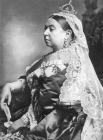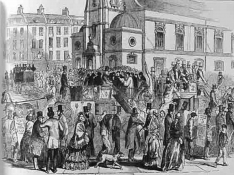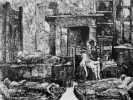





Docklands and the Thames,
Victoria Park to Paternoster
Square. Take a nostalgic
trip back to the East End in
the 1950’s or a stroll around
the Square Mile of the City
of London. It’s all here at
barryoneoff.co.uk
Copyright 2002 - 2024 ©Barry Carter. All rights reserved
64 Glorious Years
Queen Victoria was to reign longer than any monarch before her. This record lasted up until 2016 when Queen Elizabeth II surpassed it. At the age of 96 Elizabeth II died while I am doing this update (September 8th. 2022). Born on May 24, 1819, Queen Victoria was originally christened Alexandrina Victoria, after her godfather, Tsar Alexander I, but much preferred her second name. Victoria reigned for sixty four years, from 1837 to 1901. During this time there were to be many changes made to the metropolis, with large buildings being erected everywhere. The Victorians would certainly leave their mark. Because of the invention of the travelling cranes in the 19th century, there would be major construction work carried out all over the City and surrounding areas. The people of the time, and especially the monarch herself, were reputed to be clean living and of a high moral standard. But were they? Were the Victorians really as good and moral as they made themselves out to be?An Escalating Death Toll
The bad winter of 1837, the year that the young Victoria ascended to the throne, had caused a major epidemic of influenza. The death toll had risen dramatically and bodies were piling up awaiting burial. People would stand at the graveside waiting for the clergy to finish the funeral in front of theirs. Navvies had to be recruited to keep up with the demand for new graves and mourners were upset by the swearing and cursing of the men trying to force coffins into the hastily dug holes. One onlooker described the graveyards as looking like freshly ploughed fields. As well as the living being overcrowded in the city, now the dead were in need of more space. It was during Victoria’s reign that private cemeteries known collectively as “The Great Seven” were opened in London. They were: Abney Park, Brompton, Highgate, Kensal Green, Nunhead, Tower Hamlets and West Norwood.Behind The Scenes
Just like most of today's rich, the wealthy Victorian gentlemen, for the most part, were indifferent to the suffering and poverty that remained hidden behind their large houses and places of business. The ones who were born into wealth didn’t want to know what went on in the filthy tenements, and the the businessmen and industrialists cared even less. Most abused the poor they employed, causing much sickness and death amongst their workers in order to keep the money rolling in. On the other hand, there were also a few philanthropists like George Peabody around. They set up trust funds to pay for housing which are still in existence today. Prostitution was a booming business, and just as today, the rich were the ones who kept it going while preaching its evils and outwardly showing their high moral standards. Servant girls were dismissed and sent away into the worst conditions imaginable because they happened to fall pregnant. In most cases it was a member of the employers family who had caused the condition in the first place. The high moral standards were a cover up for their undercover sexual exploits. The Victorian middle, and upper classes made a great show of the perfect family. Many had a hidden seedy side. Although London was much smaller then, there were 80,000 sex workers!The Slums
Behind the squeaky-clean rows of terraced houses and grand fronted buildings, in the back streets and alleys of the City, were the slums. The further from the old walls you travelled, towards the East End of London the worse the conditions became. “The filthiest place on earth”, as described by a well to do visitor. He was referring to Whitechapel. No form of sewage disposal whatsoever. Filth in the streets. The parish of Bethnal Green had people crammed into dingy rooms, living in dirt and squalor. Ten people living in a bare attic. On the good side,the Victorians greatly improved communication links. Stagecoaches, canals, steam ships and railway system. They created a postal system with the introduction of the pre-paid penny black stamp. Photography became available, enabling better records of life. Feats of engineering became common. Brunel's Clifton suspension bridge, or my favourite Victorian structure, Tower Bridge. Unfortunately they also brutalised some historical buildings with their gaudy "improvements". The Squalor >>Graveyard Shortage
Five years before Victoria’s ascendancy to the throne there had been another great increase in the number of deaths. This was due to an outbreak of cholera. At the time, the fatalities had caused existing graveyards to quickly fill up. The lack of space for burying the dead had been a major concern for the government, and burial sites were being created further out into the suburbs. Places like Tower Hamlets, Highgate, and Brompton were called upon to supply the land to house the dead. It is hard to determine the exact number of inhabitants of the rapidly expanding London at this time, but the estimated population was close to two million and constantly rising. This was not only due to the birth rate, but also the constant flow of immigrants hoping to find the streets paved with gold. Just like the present day!The Expanding City
The original “Square Mile” had always been, and still was, expanding outwards beyond the sites of the old walls. London was growing from Middlesex into the edges of the surrounding counties of Kent, Essex, and Surrey. From the cities of London, Westminster, and the ancient borough of Southwark across the Thames, many new boroughs had been added to form, as the Victorians would later refer to it, “A town with the greatest population and number of houses, in the world”. The original area within the walls was still referred to as London, but when including the great expansion beyond the City, it was referred to as the “Metropolis”. During this period of death and overcrowding of the inhabitants, a young princess Victoria ascended to the throne on June 20th. Pollution and poverty were also at a disastrous level. The picture shows Victorian families queuing for water in the street at the communal tap.THE VICTORIANS - The splendour and the squalor























